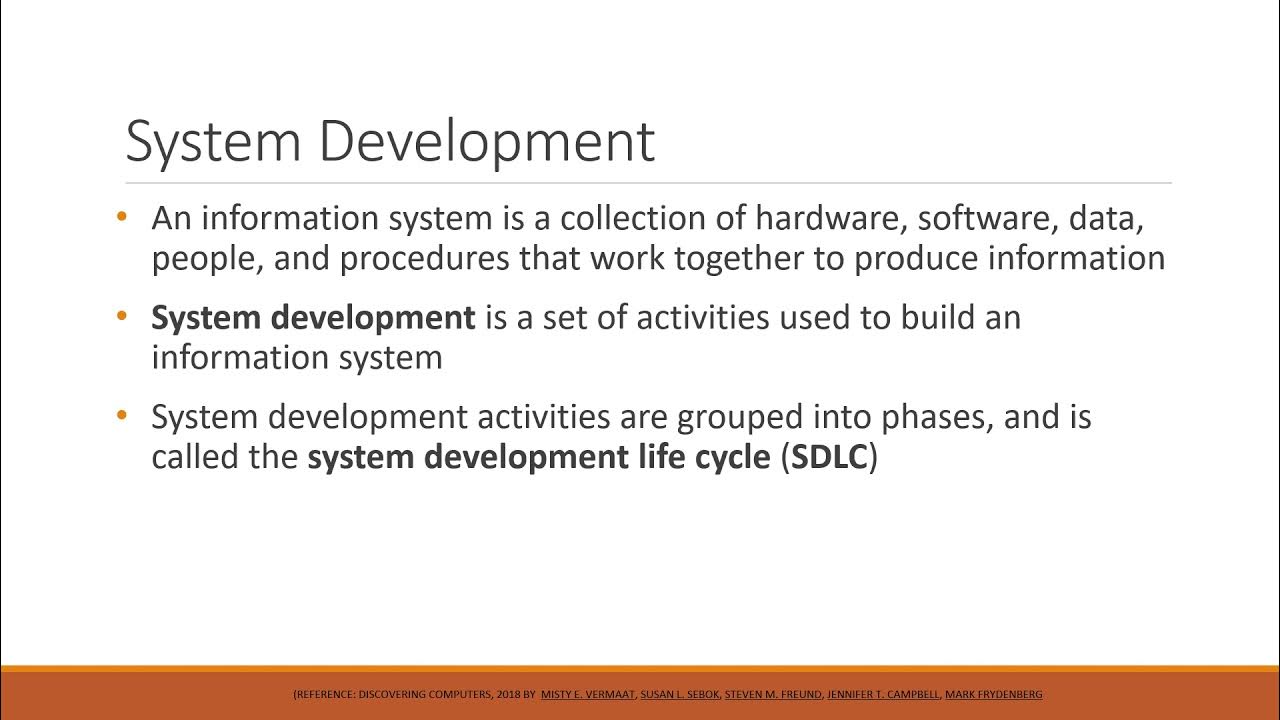Development of Information Systems Part 1
Summary
TLDRThis video discusses the development and design of information systems, focusing on the system development life cycle (SDLC). It explains the steps involved, including planning, analysis, design, implementation, and maintenance. The video emphasizes the importance of gathering requirements from various levels of management and stakeholders, and introduces tools like entity-relationship diagrams (ERD) and data flow diagrams (DFD) to structure data and processes. It also highlights the Joint Application Design (JAD) technique for collaborative development and addresses the advantages and challenges of various methodologies.
Takeaways
- 📊 Information Systems (IS) are critical for decision-making at different levels of management, and their development follows a structured process.
- 📋 The System Development Life Cycle (SDLC) is a methodology used to design, implement, and maintain information systems, following phases like planning, analysis, design, implementation, and maintenance.
- 🔍 In the planning phase, different levels of the organization (top, middle, and bottom) contribute to the requirements, prioritizing systems based on long-term and short-term goals.
- 🔄 The outcome of the planning phase is a Statement of Work (SOW), which details the IS requirements and outlines how work will be carried out.
- 📝 During the analysis phase, data, processes, and logic are gathered from different stakeholders and structured for system development.
- 📊 Tools such as Entity Relationship Diagrams (ERD), Data Flow Diagrams (DFD), and decision trees are used to document the system’s data, processes, and logic.
- 👥 Joint Application Design (JAD) is a collaborative approach where system developers, users, and stakeholders work together to design and refine the system in real-time.
- 💡 Prototyping and JAD are useful in gathering requirements but can be resource-intensive and time-consuming.
- 🛠 The analysis phase output includes documentation like ERDs, DFDs, and logic diagrams, which are passed to the design phase for further development.
- 📚 System development requires structured methods and standard tools to ensure all stakeholders understand and can collaborate effectively.
Q & A
What is the purpose of a system development life cycle (SDLC)?
-The purpose of the system development life cycle (SDLC) is to provide a structured approach to the planning, development, design, implementation, and maintenance of an information system. It aims to reduce risks and ensure that the system is designed to meet the needs of the organization at various levels.
What are the key phases of the SDLC mentioned in the transcript?
-The key phases of the SDLC mentioned in the transcript include: 1) System Planning, 2) System Analysis, 3) System Design, 4) System Implementation, and 5) System Maintenance.
Why is the planning phase important in the SDLC?
-The planning phase is crucial because it helps identify the needs for a new or modified information system. It involves understanding the requirements of different organizational levels (bottom, middle, and top) and creating a statement of work (SOW) to define the system's purpose and goals.
How do organizations prioritize which information systems to develop or modify?
-Organizations prioritize systems based on long-term and short-term goals, revenue generation, and how well they address organizational problems. The information system that best satisfies the overall needs of the organization, rather than individual department needs, is prioritized.
What is the output of the planning phase?
-The output of the planning phase is a Statement of Work (SOW) or planning document that outlines the information system's purpose, whether it will be designed, modified, or extended, and how the work will be carried out.
What is the purpose of the system analysis phase?
-The system analysis phase focuses on gathering requirements from various stakeholders, understanding the data, processes, and logic involved in the current system, and analyzing the goals and objectives of the new or modified system.
What are the three key components analyzed in the system analysis phase?
-The three key components analyzed in the system analysis phase are: 1) Data (e.g., student, faculty, course data in a student information system), 2) Process (the steps involved in using the system), and 3) Logic (the rules or calculations within the process, such as how grades are calculated).
What tools are used to structure and document the system requirements?
-To structure and document system requirements, several tools are used: Entity Relationship Diagrams (ERD) for data, Data Flow Diagrams (DFD) for processes, and tools like structure charts, decision trees, and decision tables for logic.
What is Joint Application Design (JAD), and why is it used?
-Joint Application Design (JAD) is a technique where system developers, users, and other stakeholders work together in a structured environment to define system requirements through collaboration. It is used when stakeholders cannot easily express their needs or when developers need clarification to create a suitable design.
What are the disadvantages of using JAD?
-The disadvantages of using JAD include the need for management approval to release key personnel for extended periods, potential high costs, and the requirement of significant resources to facilitate these intensive design sessions.
What is the output of the system analysis phase?
-The output of the system analysis phase is a set of structured requirements, including data (ERD), process (DFD), and logic (decision trees or tables), which are passed on to the design phase for further development.
Outlines

此内容仅限付费用户访问。 请升级后访问。
立即升级Mindmap

此内容仅限付费用户访问。 请升级后访问。
立即升级Keywords

此内容仅限付费用户访问。 请升级后访问。
立即升级Highlights

此内容仅限付费用户访问。 请升级后访问。
立即升级Transcripts

此内容仅限付费用户访问。 请升级后访问。
立即升级5.0 / 5 (0 votes)






